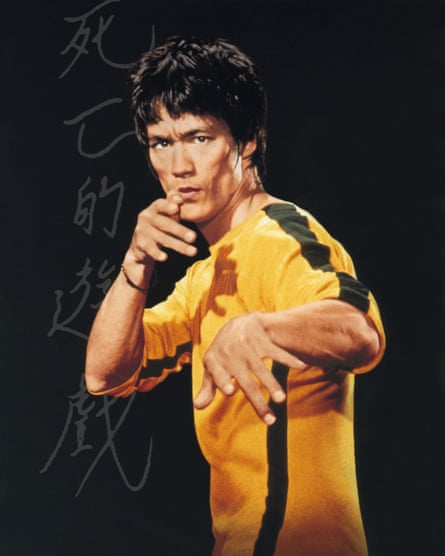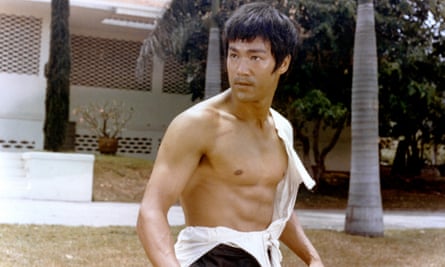Zero body-fat, anti-imperialism and Tom Cruise: Bruce Lee’s legacy 50 years after his death | Bruce Lee
It is not certain that Bruce Lee would have seen a kung fu duel involving sex toys as a fitting tribute to his legacy, but the Oscar triumph of Everything, Everywhere All At Once earlier this year is a reminder, 50 years after his death, of what a trail he has blazed. Lee smashed down the door for Asian representation pretty much single- (and bare-) handedly, even if he died too soon to be a beneficiary of it.
Lee is one of those rare stars who is bigger than his movies. Despite leaving a slim body of work – just four complete films – he practically spawned a whole genre, and wrote the book for Hollywood action to this day. Lee runs through the DNA of global culture: video games, hip-hop and mixed martial arts, not to mention the general rise of the super-fit, zero-body-fat masculine physical ideal. The fact that he died young, in perplexingly banal circumstances (a reaction to a painkiller) only burnishes his myth.
Lee also built a unique persona – intense, disciplined, physical yet cerebral – light years away from western stereotypes of Asian masculinity that were very much in play when he first came to Hollywood in the mid-1960s. He was born in San Francisco, then grew up in Hong Kong before returning to the US, aged 18). It was a time when east Asian men were depicted as servants, sinister villains or buck-toothed buffoons (often played by white actors – see Mickey Rooney in Breakfast at Tiffany’s). Lee grew exasperated at being used as a subservient sidekick in the TV series The Green Hornet. Despite training a roster of celebrity students in the martial arts (including Steve McQueen, James Coburn and Sharon Tate), Lee realised the US was not ready to accept an Asian leading man.
The final insult came with the 1970s TV series Kung Fu. Lee’s involvement in developing the show, which followed a Shaolin monk in the old west, is contested. Either way, he auditioned for the lead role, only to be passed over in favour of David Carradine, who had neither Chinese ancestry nor any knowledge of martial arts.
Returning to Hong Kong in 1971, Lee churned out four movies in two years, and exploded into global superstardom. As well as displaying his dazzling physical skills, Lee’s movies were narratives of resistance. He stood with the oppressed factory workers and against criminal corruption in The Big Boss; in Fist of Fury, he embarked on a one-man crusade against colonial oppression in 1920s Shanghai (and, by extension, British-ruled 1970s Hong Kong), forcing his Japanese adversaries to literally eat their words, describing China as “the Sick Man of east Asia”. In The Way of the Dragon, he saves the family restaurant and tears a strip off Chuck Norris at the Colosseum. It wasn’t just local audiences; Lee became a universal symbol of defiance: a man of colour seeking to express himself with the tools he had available. When Hong Kong students were resisting Chinese authoritarianism in 2019, they adopted Lee’s maxim: “Be water.”
The success of these films caught Hollywood’s attention at last, but, even with his classic Enter The Dragon (released a month after his death), Lee wasn’t trusted to carry the movie alone, so Jim Kelly and John Saxon were cast alongside him. The 70s kung fu craze fed into everything from comic books (Marvel’s Stan Lee once described Lee as “a superhero without a costume”) to pop music. By that time, Lee had also reinvigorated the Hong Kong film industry, which has sent a flow of actors westwards ever since: Jackie Chan, Jet Li, Donnie Yen, Maggie Cheung and, of course, Michelle Yeoh. Not to mention a stream of western martial artists, from Jean-Claude Van Damme to Jason Statham.
Equally significant was the export of action film-makers such as John Woo and Yuen Wo Ping, the latter of whom famously gave The Matrix its distinctive action flavour. By the 21st century, Hong Kong-flavoured action had become the must-have ingredient of action cinema and it has remained so ever since. You could draw a direct line from Lee to, say, Tom Cruise’s Mission: Impossible (Woo directed the second instalment), Marvel’s Shang-Chi (the comic was inspired by Lee) or Keanu Reeves’ John Wick (whose star and director, Chad Stahelski, both cut their teeth on The Matrix).
after newsletter promotion

And, let’s not forget Quentin Tarantino, who borrowed wholesale from Hong Kong cinema in general (Reservoir Dogs lifted the plot of Ringo Lam’s City on Fire) and, in Kill Bill, Uma Thurman wears a trademark yellow Bruce Lee tracksuit, facing off against … Carradine). Tarantino did little to return the favour in Once Upon a Time in Hollywood, which depicted Lee (played by Mike Moh) as “a little man with a big mouth”, in the words of Brad Pitt’s stunt man, who almost beats him in a fight. It was regarded as an insulting caricature by many, including Lee’s daughter, Shannon. “They didn’t need to treat him in the way that white Hollywood did when he was alive,” she said.
The problems have not totally gone away, in terms of the “whitewashing” of Asian content, stereotyping and industry underrepresentation. But, there has been progress, and it is Lee we should thank. Beyond that, he is still exhilarating to watch on screen. Much about his movies now appears dated but Lee’s physicality and presence are still awe-inspiring. He was the consummate self-made man, but also a man of the people. No wonder he still strikes a chord.
It is not certain that Bruce Lee would have seen a kung fu duel involving sex toys as a fitting tribute to his legacy, but the Oscar triumph of Everything, Everywhere All At Once earlier this year is a reminder, 50 years after his death, of what a trail he has blazed. Lee smashed down the door for Asian representation pretty much single- (and bare-) handedly, even if he died too soon to be a beneficiary of it.
Lee is one of those rare stars who is bigger than his movies. Despite leaving a slim body of work – just four complete films – he practically spawned a whole genre, and wrote the book for Hollywood action to this day. Lee runs through the DNA of global culture: video games, hip-hop and mixed martial arts, not to mention the general rise of the super-fit, zero-body-fat masculine physical ideal. The fact that he died young, in perplexingly banal circumstances (a reaction to a painkiller) only burnishes his myth.
Lee also built a unique persona – intense, disciplined, physical yet cerebral – light years away from western stereotypes of Asian masculinity that were very much in play when he first came to Hollywood in the mid-1960s. He was born in San Francisco, then grew up in Hong Kong before returning to the US, aged 18). It was a time when east Asian men were depicted as servants, sinister villains or buck-toothed buffoons (often played by white actors – see Mickey Rooney in Breakfast at Tiffany’s). Lee grew exasperated at being used as a subservient sidekick in the TV series The Green Hornet. Despite training a roster of celebrity students in the martial arts (including Steve McQueen, James Coburn and Sharon Tate), Lee realised the US was not ready to accept an Asian leading man.

The final insult came with the 1970s TV series Kung Fu. Lee’s involvement in developing the show, which followed a Shaolin monk in the old west, is contested. Either way, he auditioned for the lead role, only to be passed over in favour of David Carradine, who had neither Chinese ancestry nor any knowledge of martial arts.
Returning to Hong Kong in 1971, Lee churned out four movies in two years, and exploded into global superstardom. As well as displaying his dazzling physical skills, Lee’s movies were narratives of resistance. He stood with the oppressed factory workers and against criminal corruption in The Big Boss; in Fist of Fury, he embarked on a one-man crusade against colonial oppression in 1920s Shanghai (and, by extension, British-ruled 1970s Hong Kong), forcing his Japanese adversaries to literally eat their words, describing China as “the Sick Man of east Asia”. In The Way of the Dragon, he saves the family restaurant and tears a strip off Chuck Norris at the Colosseum. It wasn’t just local audiences; Lee became a universal symbol of defiance: a man of colour seeking to express himself with the tools he had available. When Hong Kong students were resisting Chinese authoritarianism in 2019, they adopted Lee’s maxim: “Be water.”
The success of these films caught Hollywood’s attention at last, but, even with his classic Enter The Dragon (released a month after his death), Lee wasn’t trusted to carry the movie alone, so Jim Kelly and John Saxon were cast alongside him. The 70s kung fu craze fed into everything from comic books (Marvel’s Stan Lee once described Lee as “a superhero without a costume”) to pop music. By that time, Lee had also reinvigorated the Hong Kong film industry, which has sent a flow of actors westwards ever since: Jackie Chan, Jet Li, Donnie Yen, Maggie Cheung and, of course, Michelle Yeoh. Not to mention a stream of western martial artists, from Jean-Claude Van Damme to Jason Statham.
Equally significant was the export of action film-makers such as John Woo and Yuen Wo Ping, the latter of whom famously gave The Matrix its distinctive action flavour. By the 21st century, Hong Kong-flavoured action had become the must-have ingredient of action cinema and it has remained so ever since. You could draw a direct line from Lee to, say, Tom Cruise’s Mission: Impossible (Woo directed the second instalment), Marvel’s Shang-Chi (the comic was inspired by Lee) or Keanu Reeves’ John Wick (whose star and director, Chad Stahelski, both cut their teeth on The Matrix).
after newsletter promotion

And, let’s not forget Quentin Tarantino, who borrowed wholesale from Hong Kong cinema in general (Reservoir Dogs lifted the plot of Ringo Lam’s City on Fire) and, in Kill Bill, Uma Thurman wears a trademark yellow Bruce Lee tracksuit, facing off against … Carradine). Tarantino did little to return the favour in Once Upon a Time in Hollywood, which depicted Lee (played by Mike Moh) as “a little man with a big mouth”, in the words of Brad Pitt’s stunt man, who almost beats him in a fight. It was regarded as an insulting caricature by many, including Lee’s daughter, Shannon. “They didn’t need to treat him in the way that white Hollywood did when he was alive,” she said.
The problems have not totally gone away, in terms of the “whitewashing” of Asian content, stereotyping and industry underrepresentation. But, there has been progress, and it is Lee we should thank. Beyond that, he is still exhilarating to watch on screen. Much about his movies now appears dated but Lee’s physicality and presence are still awe-inspiring. He was the consummate self-made man, but also a man of the people. No wonder he still strikes a chord.
